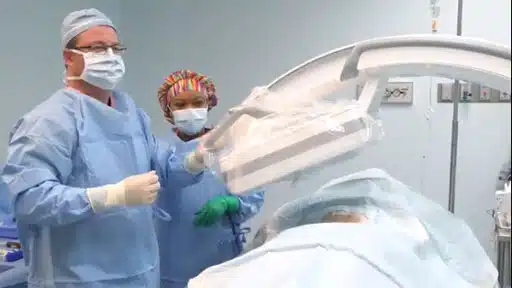Kyphoplasty (Vertebral Augmentation)
Kyphoplasty, also called vertebral augmentation, is a procedure designed to relieve back pain caused by mid- or low-back compression fractures that have not healed properly. These types of fractures are typically the result of severe bone weakening from osteoporosis due to age or long-term steroid use or vertebrae weakened by cancer.
With kyphoplasty, bone cement is injected into a damaged vertebra that has been expanded using a balloon or other device to repair the normal height of the vertebra. The cement strengthens and stabilizes the vertebra that has been damaged.
What to Expect
- We will contact you prior to your appointment to review current medications, your medical history, and potential risks. We will also answer any questions you might have about the procedure.
- The use of sedation during your procedure is at the radiologist’s discretion. If sedation is prescribed, you’ll receive detailed instructions so you know what to expect.
- If sedated, you will need someone to drive you home and stay with you for 12 hours post-procedure due to the effects of the medications.
- Be sure to tell us if you are pregnant, nursing, or if there is a chance you may be pregnant.
- Contact your doctor before you stop taking any medication.
- On the day of your exam, please arrive 15 minutes early to check in.
- Although complications are rare, we will review possible side effects and risks with you prior to your exam so you can ask questions and decide if this exam is right for you.
- When you arrive, you will be led to a changing room and given a pair of scrubs to wear for your exam. You will be given a locker to store your clothes, and anything else you may have with you during your exam.
- After you are admitted you may begin an assessment and, if necessary, undergo some laboratory tests to ensure proper blood clotting.
- Kyphoplasty is generally performed using a local anesthetic (numbing medication) and heavy sedation. A radiologist with advanced training and experience in performing spine injections will monitor you throughout the procedure.
- You will lie on your stomach on a cushioned table and the skin in the targeted area will be cleaned and numbed with a local anesthetic.
- Using X-ray guidance, the radiologist will insert a specialized needle through the skin into the damaged vertebra. The radiologist will then insert an inflatable balloon or other tool through the needle in order to reshape the bone, after which the tool is removed.
- A bone cement, which has the consistency of toothpaste, will then be injected through the needle into the bone.
- The material will begin to harden within 20 minutes, stabilizing the fractured vertebra.
- It is possible to treat more than one fractured vertebra at a time, if necessary.
- Throughout the procedure, a radiologist and nurse will closely monitor your condition and comfort level.
- After the procedure, you will be asked to stay at the center for a period of time depending on the number of fractures that are treated.
- When your procedure is complete, you’ll be escorted back to the changing room so you can change out of the scrubs and back into your clothing.
- We will provide you with rehabilitation guidelines to follow after the procedure.
- Most patients experience noticeable pain relief following the procedure.
- You may experience some mild soreness at the injection site. Please call your physician’s office if you have any concerns.
